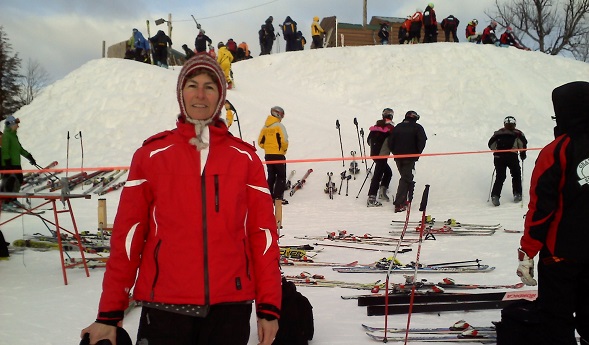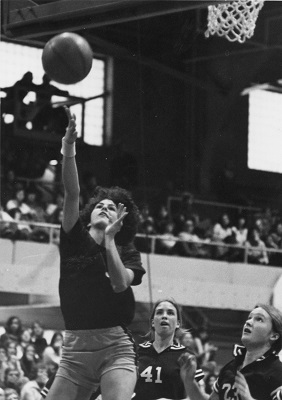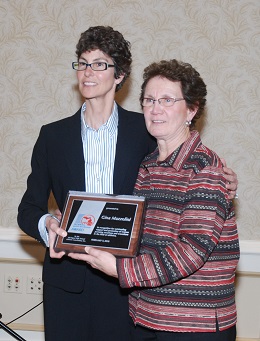
Mazzolini's Impact Felt Across Generations
By
Geoff Kimmerly
MHSAA.com senior editor
July 14, 2016
By Geoff Kimmerly
Second Half editor
A lifetime in competitive athletics has provided piles of memories for retiring MHSAA assistant director Gina Mazzolini.
 Four decades as an athlete, coach and association administrator also left her with plenty of souvenirs to sort through as she finishes her final days in the East Lansing office.
Four decades as an athlete, coach and association administrator also left her with plenty of souvenirs to sort through as she finishes her final days in the East Lansing office.
There’s a letter dated 1976 – and passed on to Mazzolini in 2004 – from the MHSAA to tennis coaches warning against stacking their lineups, an issue she’s worked to resolve over the last 20+ years.
Autographs from famous coaches John Wooden and Tom Landry made a 1991 National Federation Hall of Fame program worth saving. Just as significant was a thank-you from legendary Battle Creek St. Philip volleyball coach Sheila Guerra – who led teams to nine MHSAA titles from 1983-97 – sent in 2005 after Guerra’s daughter Vicky Groat led the Tigers to the first of what has become 10 Class D championships over the last 12 seasons.
In a number of high school sports circles, Mazzolini’s contributions are considered similarly legendary. She’s frequently been referred to as a “pioneer” – one of the first star female high school athletes from the Lansing area who went on to star at Central Michigan University and then lend her expertise to growing girls sports in this state and beyond.
“I didn’t do it because I was a woman and wanted to be the first,” Mazzolini said. “That’s just what I wanted to do, and after Title IX those jobs just opened up. And because I had some experience in coaching, officiating and playing, they took a chance on me, or they recruited me because they needed someone to run girls programs.
"I will miss people and relationships, watching things start, grow and get better.”
Mazzolini recently was recognized with a Citation from the National Federation of State High School Associations after a career that began in 1981 with Texas’ University Interscholastic League and ends after the last 23 years as an assistant director in her home state – and a mere 20 miles south of where she took the first steps toward a career that covered nearly the whole of female high school and college sports in Michigan, as a first-generation athlete and the builder of games for generations of girls and women to come.
Pioneer, indeed
Mazzolini’s senior year at St. Johns High School, 1973-74, was the first for girls basketball playoffs sponsored by the MHSAA, and Mazzolini led the Redwings to a District title that fall. She went on to star in both basketball and volleyball at CMU – still ranking among the Chippewas’ all-time hoops statistical leaders – and then to coach volleyball at Ovid-Elsie High School, Michigan State and the University of Texas.
All of that set Mazzolini up to provide a key voice and insight to rules-making bodies at the state and national levels. She’s retiring as MHSAA administrator for girls volleyball, swimming & diving, alpine skiing and tennis, and also has handled the sanctioning of out-of-state competitions and foreign exchange and international student issues. Nationally, she’s served multiple times on rules committees for soccer, swimming & diving and volleyball.
“Having worked in athletics for 46 years, I know few, if any, administrators who have a passion for excellence as does Gina Mazzolini in everything she undertakes,” wrote Marcy Weston, a retired executive associate director of athletics at CMU. “Ethics, integrity, creativity, loyalty and fortitude are just a few words that describe Gina’s work persona. And compassion, kind and supportive are words that siblings and friends access when they describe Gina.”
 Weston coached Mazzolini on the CMU volleyball team for four seasons and women’s basketball team for two. At that time, with those programs and women’s college athletics as a whole in their early stages, Mazzolini and her teammates wore the same uniforms for both sports for two years.
Weston coached Mazzolini on the CMU volleyball team for four seasons and women’s basketball team for two. At that time, with those programs and women’s college athletics as a whole in their early stages, Mazzolini and her teammates wore the same uniforms for both sports for two years.
Obviously, much has changed. And she’s played a large part.
Mazzolini first got involved as more than an athlete after taking Weston’s officiating class at CMU. Mazzolini registered as an MHSAA official – but all she knew of the MHSAA was that was where she paid her registration fee.
She still didn’t know much about state association work when offered a job at the UIL by then-executive director Bailey Marshall, who was familiar with Mazzolini because his wife Becky was the trainer for the University of Texas volleyball team when Mazzolini was an assistant coach.
“He said we’ve got to add women’s sports – they had them but not as many,” Mazzolini said. “I applied for the job and got it, and I’m still not sure what I’m going to do.”
What she lacked in initial knowledge, she made up for in passion.
Texas’ high school association at that time was adding girls tennis and soccer, beefing up some of its other offerings and reworking other sports to put females on a level playing field.
Her work there led to her first of many contributions to national rules-making committees. Early on, Mazzolini brought the perspective of someone who had played to groups that often included many who had not. She eventually chaired the volleyball committee from 2004-08 and worked with notable contributors to amateur sports including the first NCAA national coordinator of officials, Joan Powell.
“A number of people have made comments that when Gina was appointed to a national committee, the National Federation staff would breathe a sigh of relief because she would bring her patience and perspective to the table when they were forming national rules,” said MHSAA Executive Director Jack Roberts, who has served in his position since 1986.
“It’s clear to me that not just in Michigan, but across the country, there are several people who have affection for Gina as a person.”
Leaving a legacy
In addition to her recent Citation, Mazzolini is a member of the CMU Athletic Hall of Fame and received the MHSAA’s Women in Sports Leadership Award in 2010. This winter, she became the first woman to receive the MHSAA’s Charles E. Forsythe Award for her contributions to interscholastic sports.
It didn’t take long for Michigan coaches to realize she would make an impact.
 Among accomplishments she’s most proud of from her time at the MHSAA are improved relationships with the tennis and swimming communities, developed by increased communication and with the help of longtime veterans like Gary Ellis and Tiger Teusink in tennis and Denny Hill in the pool.
Among accomplishments she’s most proud of from her time at the MHSAA are improved relationships with the tennis and swimming communities, developed by increased communication and with the help of longtime veterans like Gary Ellis and Tiger Teusink in tennis and Denny Hill in the pool.
She was once told by a coach she was brave to show up at a regular-season event because of the grumbles toward the MHSAA in that sport – but soon another coach told her, “I wanted to hate you, but I like you.”
Mazzolini may choose to stick around athletics as an official, but only at the middle school level. She’ll definitely have no problems continuing to attend some of her favorite events in the sports she’s helped form over the years.
And it seems just a little coincidental that she’s stepping away from a community she’s affected so greatly at the end of the same school year that saw one of her nieces, St Johns senior Brooke Mazzolini, help the Redwings to their first MHSAA Girls Basketball Semifinal in nearly 20 years – the latest step on a path her aunt began to blaze 40 years ago, even as Gina doesn’t see herself as the “pioneer” she’s frequently made out to be.
“I played because I loved to play. I got that from my dad, and we were in an athletic neighborhood. I got into officiating and that was fun,” Mazzolini said. “And then (athletic director) Bob Forebeck at Ovid-Elsie called and said, ‘Hey I need a volleyball coach; what do you think?’ And that was a blast.
“And then I got into state associations, and I’ve really enjoyed that. There were rough patches – like when you tell people ‘no’ – but everything I’ve done, I’ve loved it. It’s hard to consider it a job, because you look forward to doing most of it.”
PHOTOS: (Top) Gina Mazzolini poses briefly while directing an MHSAA Final in skiing. (Middle) Mazzolini starred for the Central Michigan University women's basketball team. (Below) Mazzolini stands with her St. Johns high school basketball coach Beth Swears after receiving the MHSAA Women in Sports Leadership Award in 2010.

Baseball's Record-Setting Spectatorship Headlines MHSAA's 2024-25 Attendance Report
By
Geoff Kimmerly
MHSAA.com senior editor
December 12, 2025
An overall attendance record in baseball and several more all-time bests for specific rounds of other sports’ postseason tournaments kept attendance at Michigan High School Athletic Association events near 1.4 million spectators for the third-straight school year in 2024-25.
Total, MHSAA Tournament events drew 1,397,574 spectators at competitions for which admission is charged – which counts all MHSAA-sponsored sports except golf, skiing and tennis, as single tickets are not sold for those postseason events. The total of just under 1.4 million spectators is a decrease of 3.6 percent from 2023-24, but still the third-highest overall attendance over the last eight school years.
Attendance at girls events for 2024-25 was 453,320 fans, a 3.9-percent decrease from the 2023-24 record-setting total but the second-highest over the last eight years.
The boys attendance of 944,254 was 3.4 percent fewer than the previous year. However, baseball set an overall tournament record with 65,150 spectators, with records as well of 38,086 at the District level and 7,517 attending Quarterfinals. Every round of the baseball postseason saw an increase from the previous year.
Overall attendance totals for the ice hockey, team wrestling, gymnastics, boys soccer and girls swimming & diving postseason tournaments also were up from 2023-24. Ice hockey set records at its Semifinals (7,758 spectators) and Finals (7,857), boys soccer at the District level (18,219) and team wrestling also at its Finals (11,604).
Football remains the most-attended MHSAA Tournament sport and drew 361,139 spectators for its playoff series – a decrease of just above a half-percent from the previous year but with the highest Finals turnout (44,535) since 2019-20. Boys basketball attendance remained second across all seasons at 251,668 spectators, followed by girls basketball at 145,313 and girls volleyball at 110,927.
Track & field (41,418 spectators) and softball (47,763) posted their second-highest attendances on record after setting records during the 2023-24 school year.
The MHSAA is a private, not-for-profit corporation of voluntary membership by more than 1,500 public and private senior high schools and junior high/middle schools which exists to develop common rules for athletic eligibility and competition. No government funds or tax dollars support the MHSAA, which was the first such association nationally to not accept membership dues or tournament entry fees from schools. Member schools which enforce these rules are permitted to participate in MHSAA tournaments, which attract more than 1.4 million spectators each year.

